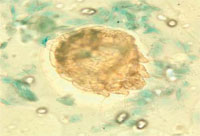What causes scabies and how is it transmitted?
Scabies (ekek in Amharic) is a parasite infestation of the skin caused by microscopic mites, Sarcoptes scabiei (figure below). These tiny animals are spread principally by direct skin-to-skin contact (e.g. during close physical contact between children and parents, or during sexual intercourse), and to a lesser extent through contact with infested clothes and bedding.

Male and female mites mate on the surface of the person's skin. The female burrows into the skin, depositing eggs in the tunnel behind her. After the eggs are hatched, larvae migrate to the skin surface and eventually change into the adult form. An adult mite can live up to about a month on a person, but they survive only two to three days once away from the human body. Individuals who become infested with scabies mites for the first time usually develop symptoms after four to six weeks, but they can still spread the mites during this time. If someone is cured of scabies, but acquires the mites again later, the symptoms appear much more quickly, within days.